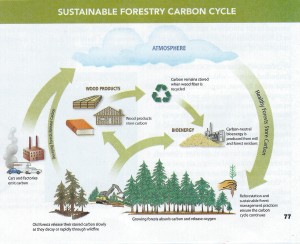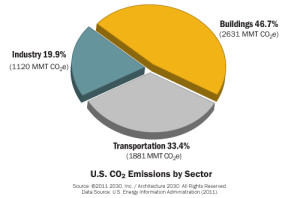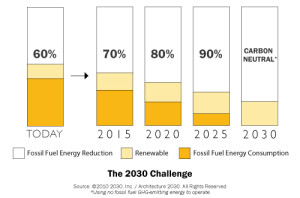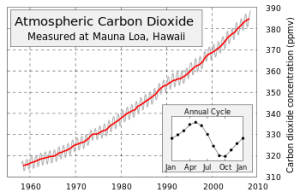Things I’ve Forgotten or Never Knew about Trees, Wood—and the Atmosphere

This post is basically an excerpt from an advertisement by reThink Wood in a professional green building magazine I get, and from a couple of green-related websites with linkage by me between ’em.
(From reThink) “Forests Absorb, Store and Release Carbon”
 As trees grow, they clean the air we breathe by absorbing carbon dioxide (CO2) from the atmosphere. They release the oxygen (O2) and incorporate the carbon (C) into their twigs, stems, roots, leaves or needles, and surrounding soil. Young, vigorously growing trees absorb the most carbon CO2, with the rate slowing as they reach maturity (typically 60-100 years, depending on species and environmental factors). A single tree can absorb more than 10 pounds of CO2 each year.
As trees grow, they clean the air we breathe by absorbing carbon dioxide (CO2) from the atmosphere. They release the oxygen (O2) and incorporate the carbon (C) into their twigs, stems, roots, leaves or needles, and surrounding soil. Young, vigorously growing trees absorb the most carbon CO2, with the rate slowing as they reach maturity (typically 60-100 years, depending on species and environmental factors). A single tree can absorb more than 10 pounds of CO2 each year.
As trees mature and then die, they start to decay and slowly release the stored carbon back into the atmosphere. Carbon is also released, but more quickly, when forests succumb to natural hazards such as wildfire, insects or disease.
Growing forests absorb, store, and release carbon over extended periods of time. Forests in the U.S. and Canada have sequestered high levels of carbon in recent decades. In both countries, net forest growth has exceeded annual forest harvests for more than 50 consecutive years. According to the “National Report on Sustainable Forests—2010,” “Total U.S. forest area, as defined for the purposes of this report, currently amounts to 751 million acres, or about one-third of the nation’s total land area. Since the beginning of the past century, the size of this inventory has been relatively stable, and the forests it represents remain largely intact…” In the U.S., forests and forest products store enough carbon each year to offset approximately 10% of the nation’s total CO2 emissions [italics mine].”
Ergo, something like 90% of the nation’s total CO2 emissions come from elsewhere. According to Architecture 2030, buildings are thought to contribute 46.7% of CO2 emissions annually  (from www.architecture2030.org).
(from www.architecture2030.org).
The 2030 Challenge, issued by Architecture 2030, calls for the elimination of Greenhouse Gas (GHG) emissions and carbon neutrality in 2030.
With any luck, your Education/Formation building will have a part in the reduction of GHGs by employing renewable energy systems. Future versions of the LEED rating systems will hone in on this goal more so.
“Buildings are the major source of global demand for energy and materials that produce by-product greenhouse gases (GHG). Slowing the growth rate of GHG emissions and then reversing it is the key to addressing climate change and keeping global average temperature below 2°C above pre-industrial levels.
To accomplish this, Architecture 2030 issued The 2030 Challenge asking the global architecture and building community to adopt the following targets:
All new buildings, developments and major renovations shall be designed to meet a fossil fuel, GHG-emitting, energy consumption performance standard of 60% below the regional (or country) average/median for that building type.
At a minimum, an equal amount of existing building area shall be renovated annually to meet a fossil fuel, GHG-emitting, energy consumption performance standard of 60% of the regional (or country) average/median for that building type.
The fossil fuel reduction standard for all new buildings and major renovations shall be increased to: 70% in 2015–80% in 2020–90% in 2025–and, Carbon-neutral in 2030 (using no fossil fuel GHG emitting energy to operate).
These targets may be accomplished by implementing innovative sustainable design strategies, generating on-site renewable power and/or purchasing (20% maximum) renewable energy.”
 THIS GOOD NEWS JUST OUT APRIL 5TH: According to “Green Energy News,” published by the U.S. Energy Information Administration, “Energy-related Carbon Dioxide Emissions Declined in 2012.” So, the trend shown in the chart to the left has eclipsed–at least for now.
THIS GOOD NEWS JUST OUT APRIL 5TH: According to “Green Energy News,” published by the U.S. Energy Information Administration, “Energy-related Carbon Dioxide Emissions Declined in 2012.” So, the trend shown in the chart to the left has eclipsed–at least for now.
“Energy-related carbon dioxide emissions in 2012 were the lowest in the United States since 1994, at 5.3 billion metric tons of CO2 . With the exception of 2010, emissions have declined every year since 2007.
The largest drop in emissions in 2012 came from coal, which is used almost exclusively for electricity generation. During 2012, particularly in the spring and early summer, low natural gas prices led to competition between natural gas- and coal-fired electric power generators. Lower natural gas prices resulted in reduced levels of coal generation, and increased natural gas generation – a less carbon-intensive fuel for power generation, which shifted power generation from the most carbon-intensive fossil fuel (coal) to the least carbon-intensive fossil fuel (natural gas).”